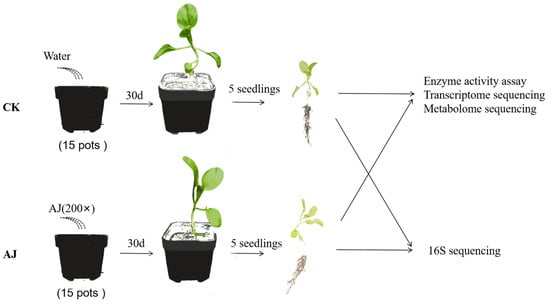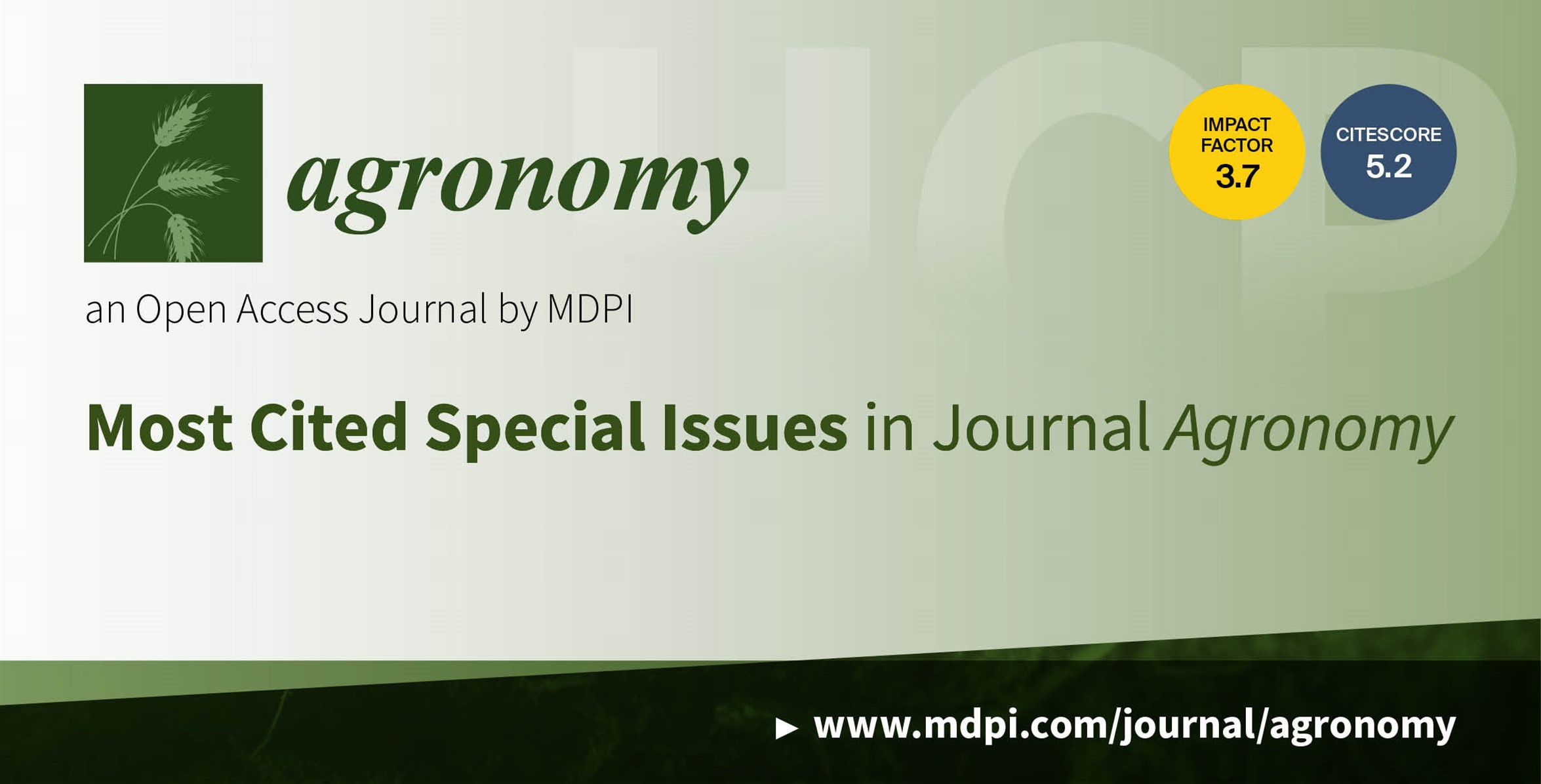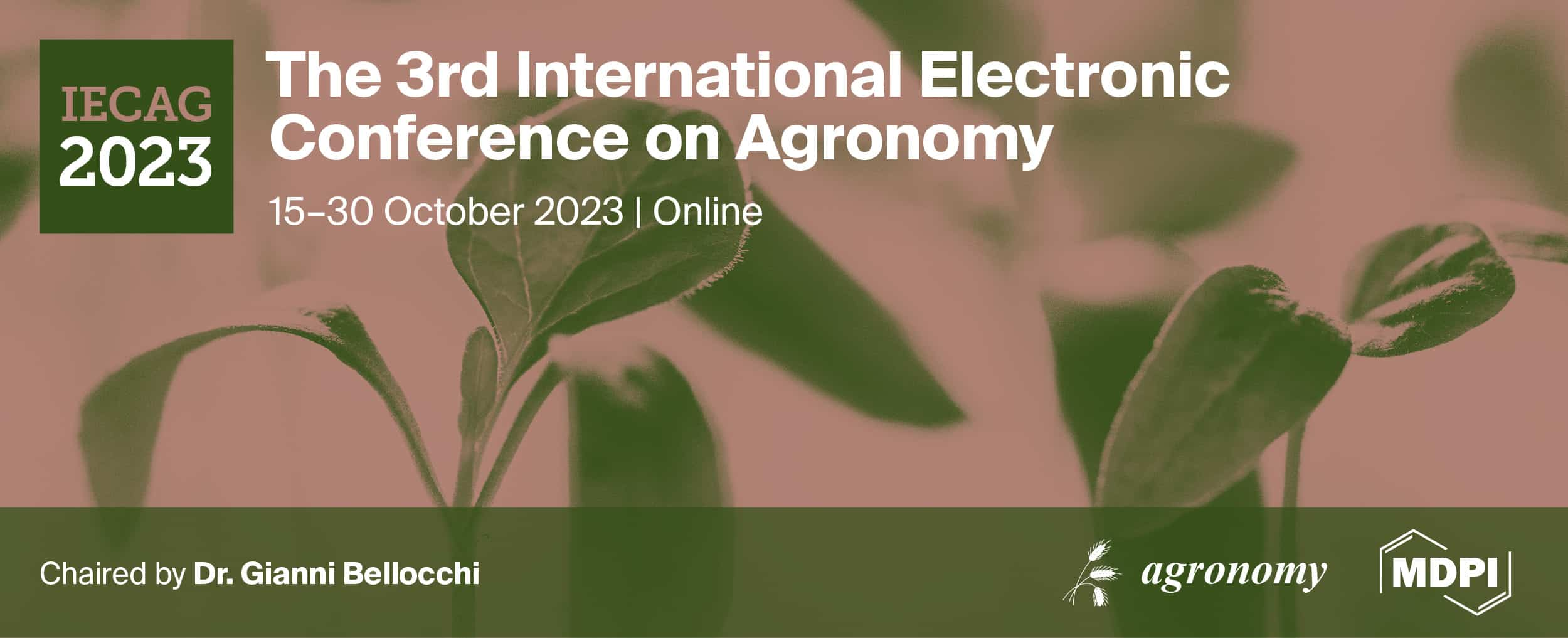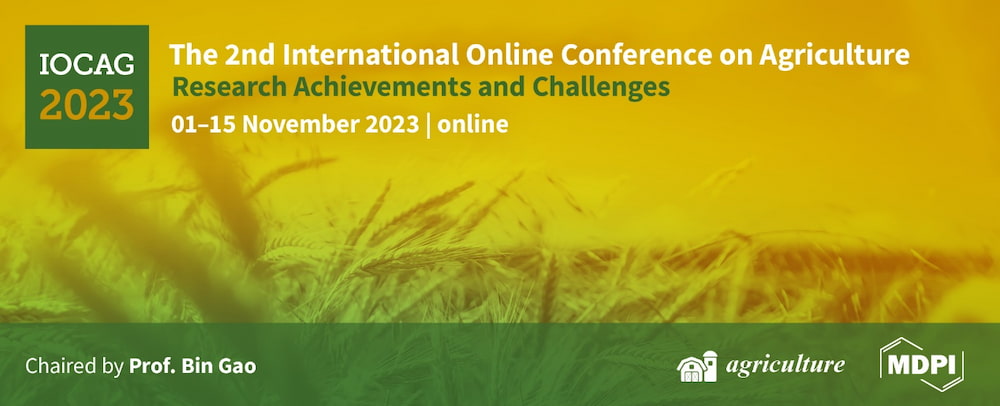-
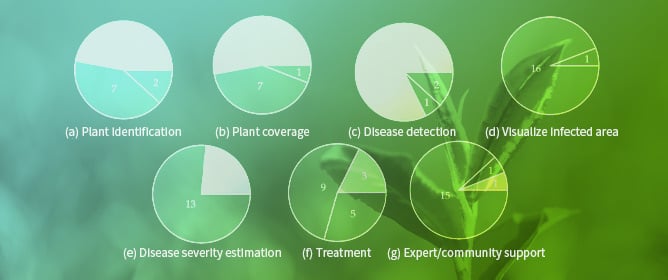 Evaluating Plant Disease Detection Mobile Applications: Quality and Limitations
Evaluating Plant Disease Detection Mobile Applications: Quality and Limitations -
 Effect of Regulated Deficit Irrigation on the Quality of 'Arbequina' Extra Virgin Olive Oil Produced on a Super-High-Intensive Orchard
Effect of Regulated Deficit Irrigation on the Quality of 'Arbequina' Extra Virgin Olive Oil Produced on a Super-High-Intensive Orchard -
 Emerging Trends in Allelopathy: A Genetic Perspective for Sustainable Agriculture
Emerging Trends in Allelopathy: A Genetic Perspective for Sustainable Agriculture -
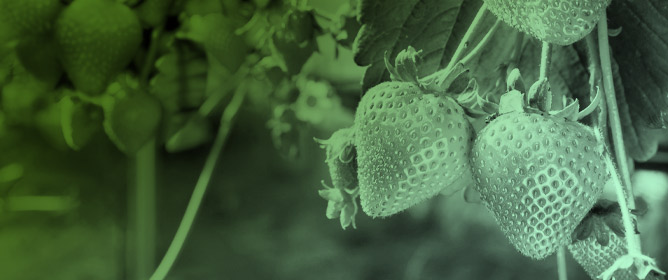 Synergistic Effect of Plant-Growth-Promoting Rhizobacteria Improves Strawberry Growth and Flowering with Soil Salinization and Increased Atmospheric CO2 Levels and Temperature Conditions
Synergistic Effect of Plant-Growth-Promoting Rhizobacteria Improves Strawberry Growth and Flowering with Soil Salinization and Increased Atmospheric CO2 Levels and Temperature Conditions
Journal Description
Agronomy
Agronomy
is an international, scientific, peer-reviewed, open access journal published monthly online by MDPI. The Spanish Society of Plant Physiology (SEFV) is affiliated with Agronomy and their members receive a discount on the article processing charges.
- Open Access— free for readers, with article processing charges (APC) paid by authors or their institutions.
- High Visibility: indexed within Scopus, SCIE (Web of Science), PubAg, AGRIS, and other databases.
- Journal Rank: JCR - Q1 (Agronomy) / CiteScore - Q1 (Agronomy and Crop Science)
- Rapid Publication: manuscripts are peer-reviewed and a first decision is provided to authors approximately 17.3 days after submission; acceptance to publication is undertaken in 2.3 days (median values for papers published in this journal in the first half of 2023).
- Recognition of Reviewers: reviewers who provide timely, thorough peer-review reports receive vouchers entitling them to a discount on the APC of their next publication in any MDPI journal, in appreciation of the work done.
- Companion journals for Agronomy include: Seeds, Agrochemicals, Grasses and Crops.
Impact Factor:
3.7 (2022);
5-Year Impact Factor:
4.0 (2022)
Latest Articles
Agricultural Jiaosu Enhances the Stress Resistance of Pak Choi (Brassica rapa L. subsp. chinensis) by Recruiting Beneficial Rhizosphere Bacteria and Altering Metabolic Pathways
Agronomy 2023, 13(9), 2310; https://doi.org/10.3390/agronomy13092310 (registering DOI) - 01 Sep 2023
Abstract
►
Show Figures
Agricultural Jiaosu (AJ) is a method of recycling agricultural wastes for improving soil properties, promoting plant growth, and enhancing plant stress resistance. However, the underlying mechanism by which AJ improves plant stress resistance needs to be determined. Therefore, in this study, two treatments
[...] Read more.
Agricultural Jiaosu (AJ) is a method of recycling agricultural wastes for improving soil properties, promoting plant growth, and enhancing plant stress resistance. However, the underlying mechanism by which AJ improves plant stress resistance needs to be determined. Therefore, in this study, two treatments of AJ spraying and water spraying were set up to determine the enzyme activities related to the stress resistance of pak choi after 30 days of growth, and the potential mechanism of AJ’s influence on the stress resistance of pak choi was revealed by transcriptome, metabolome, and rhizome microbiome analyses. Microbial community analysis revealed that the application of AJ does not alter microbial abundance in the rhizosphere; however, it can improve microbial diversity and enrich Actinobacteriota, Proteobacteria, and Firmicutes in the pak choi rhizosphere. Metabolomic analysis revealed that these phyla were significantly positively correlated, with highly upregulated metabolites. Our findings suggest that AJ recruits beneficial microorganisms (BMs) in the rhizosphere and stimulates the expression of genes and metabolites involved in phenylpropanoid and glucosinolate biosynthesis, as well as glutathione and alpha-linolenic acid metabolism pathways. The use of AJ could considerably minimise the use of pesticides and fertilisers and improve the quality of the ecological environment.
Full article
Open AccessEditorial
Innovations in Agriculture for Sustainable Agro-Systems
by
and
Agronomy 2023, 13(9), 2309; https://doi.org/10.3390/agronomy13092309 (registering DOI) - 01 Sep 2023
Abstract
Agriculture has changed dramatically and has been improved due to new technologies [...]
Full article
(This article belongs to the Special Issue Innovations in Agriculture for Sustainable Agro-Systems)
►▼
Show Figures
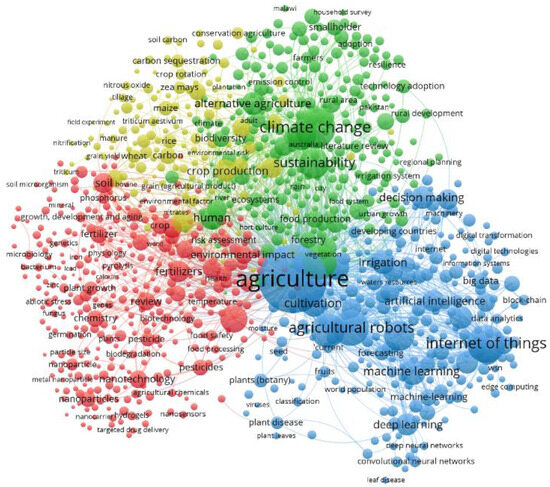
Figure 1
Open AccessEditorial
Special Issue “Recent Advances in Genomics, Genetic Resources Evaluation and Breeding of Cucurbitaceae Crops”
Agronomy 2023, 13(9), 2308; https://doi.org/10.3390/agronomy13092308 (registering DOI) - 01 Sep 2023
Abstract
Recent progress in plant genomic technologies has amounted to a revolution, making a huge set of molecular tools available for use in plant breeding [...]
Full article
(This article belongs to the Special Issue Recent Advances in Genomics, Genetic Resources Evaluation and Breeding of Cucurbitaceae Crops)
►▼
Show Figures
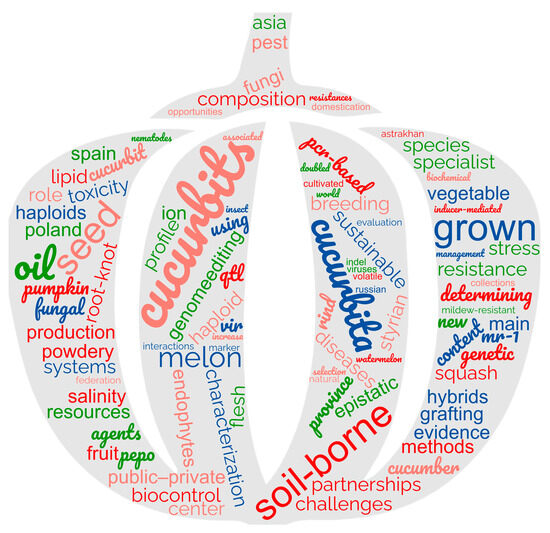
Figure 1
Open AccessArticle
Assessment of Genetic Diversity and Protein Content of Scandinavian Peas (Pisum sativum)
Agronomy 2023, 13(9), 2307; https://doi.org/10.3390/agronomy13092307 (registering DOI) - 31 Aug 2023
Abstract
We produced homogeneous lines of 227 pea accessions from the Nordic Genetic Resource Center via single seed descent. The genetic diversity among these, mostly Scandinavian accessions, was investigated using three microsatellite markers, A9, AC58 and AA5. The microsatellites were highly informative and separated
[...] Read more.
We produced homogeneous lines of 227 pea accessions from the Nordic Genetic Resource Center via single seed descent. The genetic diversity among these, mostly Scandinavian accessions, was investigated using three microsatellite markers, A9, AC58 and AA5. The microsatellites were highly informative and separated 153 of 194 accessions on a Neighbor Joining topology. The high polymorphism information content (PIC) values between 0.87 and 0.91 indicated that the gene bank material contains a large number of pea accessions with different breeding histories. The peas were grown in the field for two years and seed protein content showed variation between 9.3% and 34.1% over the years and accessions, respectively. The mean thousand seed weight was 152.05 g. More than 10 accessions had a protein content above 28%, showing that the collection has potential as breeding nursery for high-protein pea cultivars.
Full article
(This article belongs to the Special Issue Molecular Genetics, Genomics and Biotechnology of Crop Plants Breeding—Series III)
►▼
Show Figures
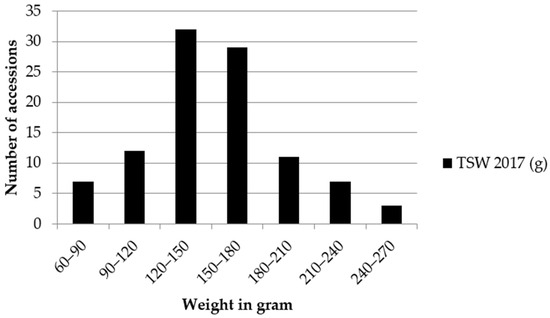
Figure 1
Open AccessArticle
Effects of Different Tillage and Residue Retention Measures on Silage Maize Yield and Quality and Soil Phosphorus in Karst Areas
Agronomy 2023, 13(9), 2306; https://doi.org/10.3390/agronomy13092306 (registering DOI) - 31 Aug 2023
Abstract
Soil phosphorus (P) limitation in karst areas has severely constrained soil quality and land productivity. To enhance silage maize yield and quality and alleviate and/or balance the low phosphorus availability in the karst areas of China, the experiment investigated the effects of different
[...] Read more.
Soil phosphorus (P) limitation in karst areas has severely constrained soil quality and land productivity. To enhance silage maize yield and quality and alleviate and/or balance the low phosphorus availability in the karst areas of China, the experiment investigated the effects of different tillage and residue retention practices on silage maize yield and quality and soil phosphorus in this region. The treatment set included: conventional tillage (CT), conventional tillage and root stubble retention (CTH), conventional tillage and mulch (CTM), conventional tillage and crushing and incorporation of hairy vetch by tillage (CTR), no tillage (NT), no tillage and root stubble retention (NTH), no tillage and mulch (NTM), and no tillage and living mulch (NTLM). The results showed that CTM, NTM, CTR, and NTLM significantly increased the height and LAI of silage maize compared with the CT, NT, and NTH treatments. CTM, CTR, and NTM significantly enhanced maize yield. Compared with conventional tillage, not tilling had a more pronounced improvement in silage quality, whereas residue retention hardly affected corn quality. In addition, although not tilling does not significantly increase acid phosphatase activity, it appeared to be advantageous in increasing soil microbial phosphorus and available phosphorus content when combined with cover crop measures. Ultimately, we concluded that NTM and NTLM are beneficial for silage maize yield and quality and soil phosphorus content in karst areas and verified the advantages of combining no tillage and residue retention practices for silage maize production and soil phosphorus improvement in the karst areas of China.
Full article
(This article belongs to the Special Issue Evaluate the Functional Value of Agroecosystem under Different Management Scenarios)
►▼
Show Figures
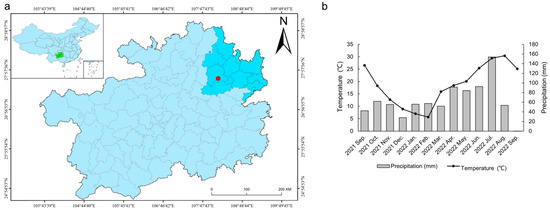
Figure 1
Open AccessArticle
Improvement of Fruit Quality and Phytochemical Components of Pomegranate by Spraying with B2O3 and ZnO Nanoparticles
by
, , , , , and
Agronomy 2023, 13(9), 2305; https://doi.org/10.3390/agronomy13092305 (registering DOI) - 31 Aug 2023
Abstract
Pomegranate is one of the most important and widely distributed trees. Boron and zinc are important nutrients for plant growth and fruit quality. Nanotechnology has emerged as one of the most innovative scientific fields in agriculture. This study was conducted to describe the
[...] Read more.
Pomegranate is one of the most important and widely distributed trees. Boron and zinc are important nutrients for plant growth and fruit quality. Nanotechnology has emerged as one of the most innovative scientific fields in agriculture. This study was conducted to describe the changes in the physiochemical characteristics (weight, diameter, length, firmness and color), as well as the phytochemicals attributes (total phenolics, total flavonoids, ascorbic acid, anthocyanin and antioxidant %) and minerals contents, of pomegranates fruits of the ‘Wonderful’ cultivar as a result of spraying pomegranate trees using nanomaterials (zinc oxide (ZnONPs) and boron oxide (B2O3NPs)). In three successive developmental stages (full bloom, 6 weeks after full bloom and one month before harvest time), the trees were sprayed with 0.25, 0.5 and 1 g/L ZnONPs, as well as 0.25, 0.5 and 1 g/L B2O3NPs during the 2021 and 2022 seasons. The application of ZnONPs and B2O3NPs influenced the qualitative characteristics of the fruits in the studied seasons. The highest marketable % was observed for the 0.50 and 1 g/L ZnONPs and 1 g/L B2O3NPs compared to the other treatments. Also, a positive effect was recorded for the ZnONPs and B2O3NPs on the fruits’ physical properties. All of the ZnONP and B2O3NP treatments resulted in increasing the total phenolic, flavonoid, anthocyanin and ascorbic acid contents and the antioxidant activity in the pomegranate juices. In conclusion, our results suggest that spraying pomegranate trees with ZnONPs and B2O3NPs improves the marketable fruit, enhances the fruit quality and increases the bioactive components and antioxidant activity.
Full article
(This article belongs to the Special Issue Effect of Cultivation Techniques on Fruit Quality and Nutritional Value—Series II)
►▼
Show Figures
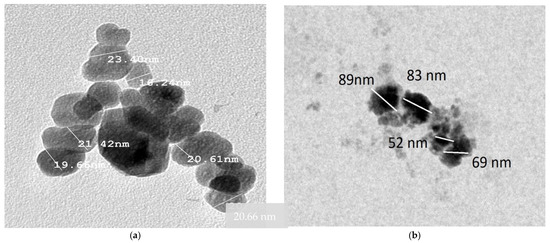
Figure 1
Open AccessArticle
Organic Manure Significantly Promotes the Growth of Oilseed Flax and Improves Its Grain Yield in Dry Areas of the Loess Plateau of China
by
, , , , , , , , and
Agronomy 2023, 13(9), 2304; https://doi.org/10.3390/agronomy13092304 - 31 Aug 2023
Abstract
Organic fertilizers could be useful for agricultural sustainability. Therefore, this study explored green cultivation techniques to improve the grain yield of oilseed flax in dry areas of the Loess Plateau of China. With no fertilization (CK) as the control, the effects of sheep
[...] Read more.
Organic fertilizers could be useful for agricultural sustainability. Therefore, this study explored green cultivation techniques to improve the grain yield of oilseed flax in dry areas of the Loess Plateau of China. With no fertilization (CK) as the control, the effects of sheep manure (S1: 12.5 t ha−1; S2: 25 t ha−1), poultry manure (C1: 5.8 t ha−1; C2: 11.6 t ha−1), and chemical fertilizers (F1: N 112 kg ha−1, P 75 kg ha−1, K 67.5 kg ha−1; F2: N 225 kg ha−1, P 150 kg ha−1, K 135 kg ha−1) on the growth and development, the grain filling characteristics, and the yield of the Zhangya 2 oilseed flax (Linum usitatisimum L.) variety were compared and analyzed based on a two-factor split plot experiment. The results showed that the application of manure significantly increased the emergence rate (ER) of oilseed flax. Poultry manure increased plant height while sheep manure increased stem diameter. The dry matter production was higher in the 25 t ha−1 sheep manure treatment by 2.47–40.11% compared with that of the other treatments, and it promoted the distribution ratio of dry matter to grains after anthesis. The observed relationship was in accordance with that presented by the logistic equation between grain weight and days after anthesis, and there were significant positive correlations between the 1000-grain weight and the average filling rate (V-ave), the maximum filling rate (V-max), and the growth at the maximum filling rate (W-max). The application of organic manure accelerated the grain filling rate (GFR); under the treatment with 25 t ha−1 sheep manure, V-ave, V-max, and W-max increased by 4.84–22.72%, 1.16–17.54%, and 4.58–22.63%, respectively, and the grain yield and the net income per unit area increased by 6.35–39.25% and 3.04–95.07%, respectively, compared with those under the other treatments. Consequently, the treatment with 25 t ha−1 sheep manure can significantly promote the growth and development of oilseed flax plants, optimize the grain filling characteristics, and increase the grain yield and net income, making it a suitable fertilization technique for oilseed flax in dry areas of the Loess Plateau of China.
Full article
(This article belongs to the Section Farming Sustainability)
►▼
Show Figures

Figure 1
Open AccessArticle
The Impact of Greenhouse and Field Growth Conditions on Chenopodium quinoa Willd Accessions’ Response to Salt Stress: A Comparative Approach
by
, , , , , and
Agronomy 2023, 13(9), 2303; https://doi.org/10.3390/agronomy13092303 (registering DOI) - 31 Aug 2023
Abstract
Quinoa’s exceptional capacity to tolerate high salt levels presents a promising solution to the agricultural challenges posed by salt stress. This study aimed to explore salt stress effects on three quinoa accessions (18 GR, R-132, and DE-1) and to compare the influence of
[...] Read more.
Quinoa’s exceptional capacity to tolerate high salt levels presents a promising solution to the agricultural challenges posed by salt stress. This study aimed to explore salt stress effects on three quinoa accessions (18 GR, R-132, and DE-1) and to compare the influence of greenhouse and field growing conditions on their salinity tolerance. The plants were irrigated by 50, 100, 150, and 200 mM NaCl concentrations. The results showed that quinoa plants’ response to morphological, physiological, biochemical, and enzymatic parameters was influenced by NaCl concentration, accession, growing conditions, and their interactions. As salinity irrigation increased, aerial part length and leaf area decreased significantly (p < 0.05) for all studied accessions, correlating with plant photosynthetic parameters. Greenhouse conditions promote faster and more vigorous growth with a larger leaf area compared to field cultivation. Furthermore, at 200 mM concentration, the DE-1 accession displayed greater photosynthetic activity, recording values of 195.66 ± 3.56 and 120 ± 1.13 µmol·m−2·s−1 for greenhouse and open field conditions, respectively. NaCl stimulated MDA and H2O2 in both conditions for all accessions, and the DE-1 accession displayed the lowest levels. Proteins, sugars, proline, peroxidase, ascorbate peroxidase, and catalase were stimulated by salt stress, except in the R-132 accession. Field cultivation resulted in a more severe salinity response. Greenhouse conditions may enhance quinoa’s salt tolerance due to the less demanding growth conditions. DE-1 exhibited the highest salt tolerance, while R-132 showed the lowest. This study sets the stage for further research into the genetic basis of salt tolerance in various quinoa accessions, optimizing growth in salty regions through farming practices, and confirming the obtained results in real-world conditions for sustainable agriculture.
Full article
(This article belongs to the Special Issue Adaptation of Crops to the Environment under Climate Change: Physiological and Agronomic Strategies - Series II)
►▼
Show Figures
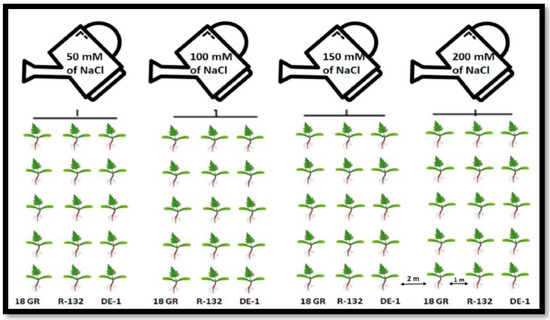
Figure 1
Open AccessReview
Machine Learning-Driven Remote Sensing Applications for Agriculture in India—A Systematic Review
Agronomy 2023, 13(9), 2302; https://doi.org/10.3390/agronomy13092302 - 31 Aug 2023
Abstract
In India, agriculture serves as the backbone of the economy, and is a primary source of employment. Despite the setbacks caused by the COVID-19 pandemic, the agriculture and allied sectors in India exhibited resilience, registered a growth of 3.4% during 2020–2121, even as
[...] Read more.
In India, agriculture serves as the backbone of the economy, and is a primary source of employment. Despite the setbacks caused by the COVID-19 pandemic, the agriculture and allied sectors in India exhibited resilience, registered a growth of 3.4% during 2020–2121, even as the overall economic growth declined by 7.2% during the same period. The improvement of the agriculture sector holds paramount importance in sustaining the increasing population and safeguarding food security. Consequently, researchers worldwide have been concentrating on digitally transforming agriculture by leveraging advanced technologies to establish smart, sustainable, and lucrative farming systems. The advancement in remote sensing (RS) and machine learning (ML) has proven beneficial for farmers and policymakers in minimizing crop losses and optimizing resource utilization through valuable crop insights. In this paper, we present a comprehensive review of studies dedicated to the application of RS and ML in addressing agriculture-related challenges in India. We conducted a systematic literature review following the Preferred Reporting Items for Systematic Reviews and Meta-Analysis (PRISMA) guidelines and evaluated research articles published from 2015 to 2022. The objective of this study is to shed light on the application of both RS and ML technique across key agricultural domains, encompassing “crop management”, “soil management”, and “water management, ultimately leading to their improvement. This study primarily focuses on assessing the current status of using intelligent geospatial data analytics in Indian agriculture. Majority of the studies were carried out in the crop management category, where the deployment of various RS sensors led yielded substantial improvements in agricultural monitoring. The integration of remote sensing technology and machine learning techniques can enable an intelligent approach to agricultural monitoring, thereby providing valuable recommendations and insights for effective agricultural management.
Full article
(This article belongs to the Special Issue Transforming AgriFood Systems under a Changing Climate)
►▼
Show Figures
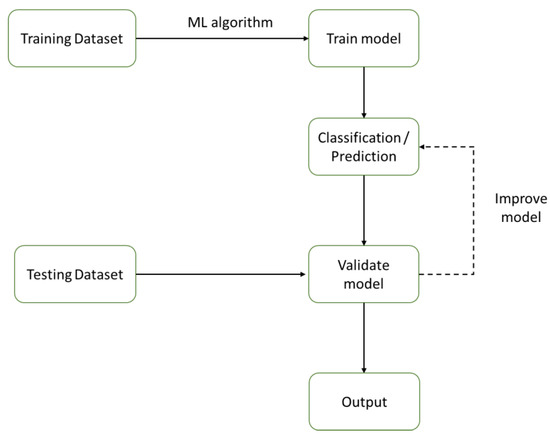
Figure 1
Open AccessArticle
The Effect of the Mixing Ratio of Barley and Mung Bean Seeds on the Quality of Sprouted Green Fodder and Silage in a Hydroponic System
by
Agronomy 2023, 13(9), 2301; https://doi.org/10.3390/agronomy13092301 - 31 Aug 2023
Abstract
Securing good feed and sustaining production is one of the main pillars of the livestock production sector. However, this is difficult to achieve in many different environments or circumstances. The production of fodder in a hydroponic system allows for sustainable production throughout the
[...] Read more.
Securing good feed and sustaining production is one of the main pillars of the livestock production sector. However, this is difficult to achieve in many different environments or circumstances. The production of fodder in a hydroponic system allows for sustainable production throughout the year and provides many benefits to the animal. However, ways must be found to improve the quality of hydroponic fodder and extend its shelf life. In this study, hydroponic barley fodder was produced by mixing it with mung bean seeds at different mixing ratios. In addition, silage was prepared from the resulting fodder by mixing it with barley straw to reduce the high moisture. The results of this study showed that the proportions of the components of nutritional value in the produced fodder were increased, especially the proportion of proteins, when the percentage of mung beans in the mixture was increased. In addition, the preservation of hydroponic fodder using the silage method resulted in obtaining a higher percentage of dry matter compared to fresh fodder and increased the preservation time. This brings many advantages to farmers and livestock producers, as well as researchers in the field, to expand the scope of experiments to other fodder mixtures and the sustainable production of good fodder in hydroponic systems.
Full article
(This article belongs to the Special Issue Prospects for the Development of Silage and Green Fodder)
►▼
Show Figures
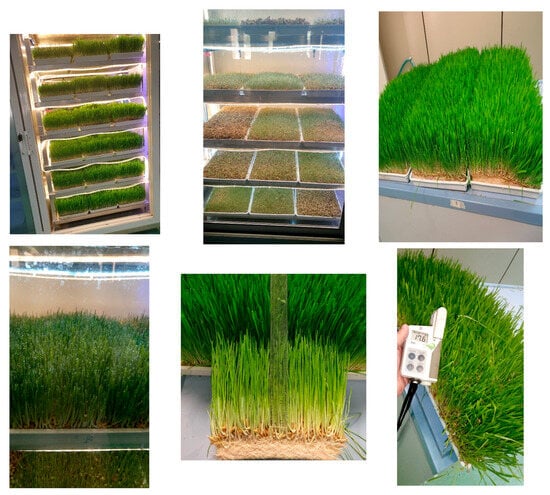
Figure 1
Open AccessReview
Tracing the Element: The Molecular Bases of Molybdenum Homeostasis in Legumes
Agronomy 2023, 13(9), 2300; https://doi.org/10.3390/agronomy13092300 - 31 Aug 2023
Abstract
The optimization of all constituent conditions to obtain high and even maximum yields is a recent trend in agriculture. Legumes play a special role in this process, as they have unique characteristics with respect to storing protein and many other important components in
[...] Read more.
The optimization of all constituent conditions to obtain high and even maximum yields is a recent trend in agriculture. Legumes play a special role in this process, as they have unique characteristics with respect to storing protein and many other important components in their seeds that are useful for human and animal nutrition as well as industry and agriculture. A great advantage of legumes is the nitrogen fixation activity of their symbiotic nodule bacteria. This nitrogen self-sufficiency contributes directly to the challenging issue of feeding the world’s growing population. Molybdenum is one of the most sought-after nutrients because it provides optimal conditions for the maximum efficiency of the enzymes involved in nitrogen assimilation as well as other molybdenum-containing enzymes in the host plant and symbiotic nodule bacteria. In this review, we consider the most optimal way of providing legume plants with molybdenum, its distribution in ontogeny throughout the plant, and its accumulation at the end of the growing season in the seeds. Overall, molybdenum supply improves seed quality and allows for the efficient use of the micronutrient by molybdenum-containing enzymes in the plant and subsequently the nodules at the initial stages of growth after germination. A sufficient supply of molybdenum avoids competition for this trace element between nitrogenase and nodule nitrate reductase, which enhances the supply of nitrogen to the plant. Finally, we also consider the possibility of regulating molybdenum homeostasis using modern genetic approaches.
Full article
(This article belongs to the Section Plant-Crop Biology and Biochemistry)
►▼
Show Figures
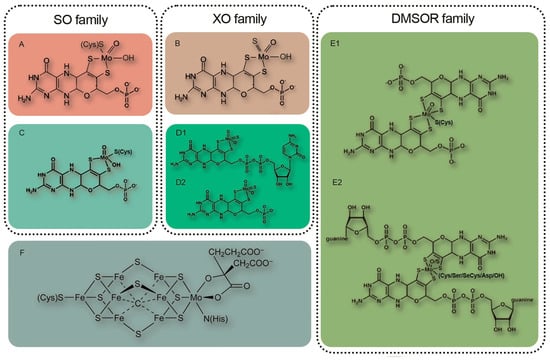
Figure 1
Open AccessArticle
Changes in Molecular Structure of Humic Substances in Cambisols under Agricultural Use
by
and
Agronomy 2023, 13(9), 2299; https://doi.org/10.3390/agronomy13092299 - 31 Aug 2023
Abstract
Soil organic matter stability and transformation affected by agriculture is a global problem of great concern. This study aimed to reveal structural changes in humic molecules under conventional soil tillage in Cambisols of the Transbaikal area. Humic acids were isolated from the humus
[...] Read more.
Soil organic matter stability and transformation affected by agriculture is a global problem of great concern. This study aimed to reveal structural changes in humic molecules under conventional soil tillage in Cambisols of the Transbaikal area. Humic acids were isolated from the humus horizons of native and arable variants of Eutric Cambisol Cryic (gleyic, humic, loamic) from the forest steppe, and Haplic Cambisol (arenic, humic, protocalcic) from the steppe zone. The changes in the humic substances’ quality were evaluated by means of an elemental analysis and 13C nuclear magnetic resonance spectroscopy. The results indicate that different agronomic management affected the changes in the composition and molecular structure of humic acids. Soil tillage induced an increase in the carbon content, the proportion of aromatic compounds and carboxyl groups and the depletion in nitrogen. As measured by 13C NMR spectroscopy, the intensity of these changes was determined by soil properties and the hydrothermal regime. Organic matter from Eutric Cambisol Cryic was suggested as providing significant environmental resistance to the agricultural impact due to the optimization of the water regime and a loamy texture. Prolonged ploughing of sandy Haplic Cambisol under the arid conditions promoted deep changes in the humic substances’ composition and chemical structure.
Full article
(This article belongs to the Special Issue Organic Matter of Arable and Anthropogenically Disturbed Soils)
►▼
Show Figures

Figure 1
Open AccessArticle
Calibration and Modeling of Parameters for Kale Root Stubble Simulation Based on the Discrete Unit Method
Agronomy 2023, 13(9), 2298; https://doi.org/10.3390/agronomy13092298 - 31 Aug 2023
Abstract
Today, the post-harvest root stubble treatment of kale in Hunan mostly uses manual pulling and centralized treatments, which are inefficient and labor-intensive. In this study, to realize the direct mechanical crushing of kale root stubble and return it to the field after harvesting,
[...] Read more.
Today, the post-harvest root stubble treatment of kale in Hunan mostly uses manual pulling and centralized treatments, which are inefficient and labor-intensive. In this study, to realize the direct mechanical crushing of kale root stubble and return it to the field after harvesting, we established an accurate simulation model of kale root stubble by creating a model of the root stubble of kale and calibrating the parameters of the simulation. This study took Jingfeng No. 1 kale stubble as the research object and used EDEM2021.2 simulation software to study the parameters of the kale stubble-crushing simulation model. The peak shear force of the sheared kale root stubble was used as the test data, and the most significant factors affecting the shear force were screened out through the Plackett–Burman test for the Design-Expert design. In addition, the steepest climb test and Box–Behnken test were used to accurately assess the factor data to obtain the best simulation value, which was 861.02 N. The relative error between the simulated and measured values was 0.61%. Finally, an accurate simulation stubble model was established by combining the best simulation parameters with the measured stubble length and diameter. This model provides a theoretical basis and technical support for more in-depth research on stubble simulation and mechanized stubble return.
Full article
(This article belongs to the Section Precision and Digital Agriculture)
►▼
Show Figures

Figure 1
Open AccessBrief Report
Genome-Wide Investigation of Knotted Related Homeobox Genes and Identification of a Fiber-Growth-Repressed Knotted Related Homeobox Gene in Ramie
by
, , , , , , , , and
Agronomy 2023, 13(9), 2297; https://doi.org/10.3390/agronomy13092297 - 31 Aug 2023
Abstract
The KNOX transcription factor plays crucial roles in regulating fiber growth in plants. Although the genome of ramie, an important fiber crop in China, is available, knotted related homeobox (KNOX) genes have not been systematically explored in this crop. In this study,
[...] Read more.
The KNOX transcription factor plays crucial roles in regulating fiber growth in plants. Although the genome of ramie, an important fiber crop in China, is available, knotted related homeobox (KNOX) genes have not been systematically explored in this crop. In this study, seven members of the KNOX gene from the ramie genome were identified and assigned to two groups, Class I and II. The intron–exon structure, conserved domain architecture, cis-regulating elements, and expression pattern showed distinct differences among the seven KNOX regulators. One of the genes, Bnt07G011994, encodes an ortholog of Arabidopsis fiber-growth-related KNAT7, and is differentially expressed among barks undergoing different stages of fiber growth. The overexpression of Bnt07G011994 dramatically decreases the fiber number in transgenic Arabidopsis, indicating a negative role played by this gene in modulating fiber growth. Further transcriptome analysis of transgenic Arabidopsis revealed that the overexpression of Bnt07G011994 resulted in an expression change in 14 pectin biosynthesis-/metabolism-related genes. These findings provide a useful foundation for further investigating the function of KNOX genes in ramie, and provide an important insight into the involvement of the ramie KNOX gene in fiber growth.
Full article
(This article belongs to the Special Issue Genomics and Genetic Improvement of Bast Fiber Plants)
►▼
Show Figures
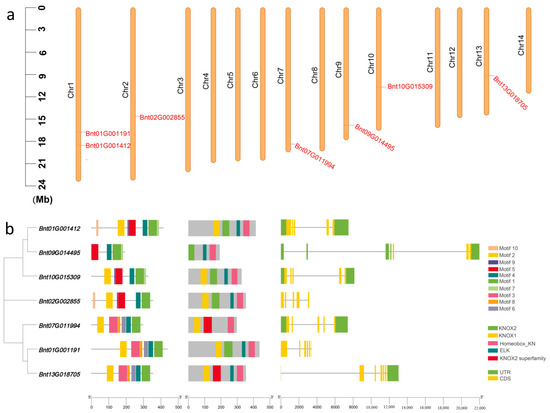
Figure 1
Open AccessArticle
Characteristics and Driving Factors of Precipitation-Use Efficiency across Diverse Grasslands in Chinese Loess Plateau
Agronomy 2023, 13(9), 2296; https://doi.org/10.3390/agronomy13092296 - 30 Aug 2023
Abstract
Understanding the characteristics of the precipitation-use efficiency (PUE) of grassland ecosystems and its drivers is critical for predicting how ecosystem functions will respond to future climate change. In this study, we investigated several covarying biotic and abiotic factors (e.g., biomass, coverage, diversity, precipitation,
[...] Read more.
Understanding the characteristics of the precipitation-use efficiency (PUE) of grassland ecosystems and its drivers is critical for predicting how ecosystem functions will respond to future climate change. In this study, we investigated several covarying biotic and abiotic factors (e.g., biomass, coverage, diversity, precipitation, temperature, and humid index (HI)) of 81 sites across a broad natural grassland gradient in the Loess Plateau of China to determine how PUE changes along a precipitation gradient and to assess the effects of biotic and abiotic factors on PUE. Our results showed that HI, below-ground biomass (BGB), vegetation coverage, and species diversity were the most important biotic factors in controlling PUE. HI had a higher positive indirect effect on PUE mainly through its influence on community characteristics. Our results suggest that precipitation and community characteristics are both important for the precipitation-use efficiency of natural grasslands across the arid and semiarid areas of the Loess Plateau. Additionally, improving the vegetation structure and increasing species diversity can help enhance the adaptability of grassland ecosystems to climate change.
Full article
(This article belongs to the Special Issue Advance in Grassland Productivity and Sustainability)
►▼
Show Figures

Figure 1
Open AccessArticle
Industrial-Scale Composting of Rice Straw and Sewage Sludge
Agronomy 2023, 13(9), 2295; https://doi.org/10.3390/agronomy13092295 - 30 Aug 2023
Abstract
Composting is an interesting option to recycle big quantities of organic waste because it helps to mitigate different environmental problems. Complementary characteristics of rice straw (RS) and sewage sludge (SS) create a suitable mixture to be used in a composting process. This work
[...] Read more.
Composting is an interesting option to recycle big quantities of organic waste because it helps to mitigate different environmental problems. Complementary characteristics of rice straw (RS) and sewage sludge (SS) create a suitable mixture to be used in a composting process. This work studies industrial-scale RS and SS composting to assess both its viability and optimization. Windrow composting was conducted during two seasons. The complete characterisation (moisture, pH, electrical conductivity, total, oxidisable and water-soluble organic carbon, humic substances, organic and mineral nitrogen, macronutrients, micronutrients, heavy metals) of starting materials, samples taken periodically and final composts were carried out. During the first season, an RS:SS ratio of 1:8 (w:w fresh weight) was used, which led to a process with adequate temperatures for biodegradation, but not for ensuring materials’ sanitation. During the second season, the RS:SS ratio was increased (1:6) to enhance the energy process and, thus, temperatures. Although this increase took place, degradation slowed down as oxidisable organic carbon and water-soluble organic carbon indicated. During both seasons, final composts presented adequate pH, high N-richness, and interesting macro- and micronutrient values. Notwithstanding, they also presented certain salinity and high ammonium contents, which must be considered for their field application. The obtained composts have interesting agronomic characteristics, which suggest their potential as an alternative to conventional fertilisers.
Full article
(This article belongs to the Special Issue Composting as a Key Driver for Sustainable Agricultural Scenarios—Volume II)
►▼
Show Figures
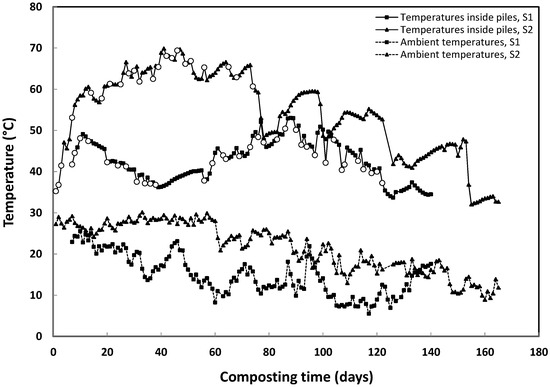
Figure 1
Open AccessArticle
Sensitivity Analysis of the WOFOST Crop Model Parameters Using the EFAST Method and Verification of Its Adaptability in the Yellow River Irrigation Area, Northwest China
Agronomy 2023, 13(9), 2294; https://doi.org/10.3390/agronomy13092294 - 30 Aug 2023
Abstract
Sensitivity analysis, calibration, and verification of crop model parameters improve crop model efficiency and accuracy, facilitating its application. This study selected five sites within the Ningxia Yellow River Irrigation Area. Using meteorological data, soil data, and field management information, the EFAST (Extended Fourier
[...] Read more.
Sensitivity analysis, calibration, and verification of crop model parameters improve crop model efficiency and accuracy, facilitating its application. This study selected five sites within the Ningxia Yellow River Irrigation Area. Using meteorological data, soil data, and field management information, the EFAST (Extended Fourier Amplitude Sensitivity Test) method was used to conduct first-order and global sensitivity analyses of spring wheat parameters in the WOFOST (World Food Studies Simulation) Model. A Structural Equation Model (SEM) analyzed the contribution of crop parameters to different simulation indices, with parameter sensitivity rankings being discussed under varying water supply and climate conditions. Finally, the adapted WOFOST model was employed to assess its applicability in the Ningxia Yellow River Irrigation Area. TMNFTB3.0 (correction factor of total assimilation rate at 3 °C), SPAN (life span of leaves growing at 35 °C), SLATB0 (specific leaf area in the initial period), and CFET (correction factor transpiration rate) showed higher sensitivity index for most simulation indices. Under the same meteorological conditions, different water supply conditions have a limited impact on crop parameter sensitivity, mainly affecting leaf senescence, leaf area, and assimilate conversion to storage organs. The corrected crop parameters significantly enhanced the wheat yield simulation accuracy by the WOFOST model (
(This article belongs to the Section Precision and Digital Agriculture)
►▼
Show Figures
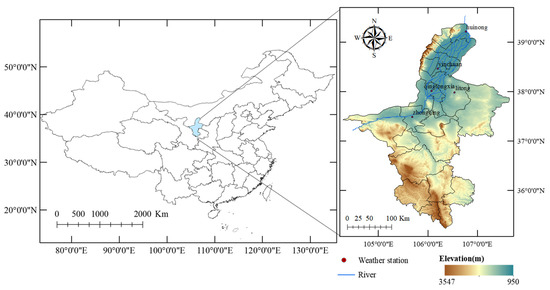
Figure 1
Open AccessArticle
How Weather and Fertilization Affected Grain Yield and Stability of Winter Wheat in a Long-Term Trial in the South Moravian Region, Czech Republic
Agronomy 2023, 13(9), 2293; https://doi.org/10.3390/agronomy13092293 - 30 Aug 2023
Abstract
We evaluated the impact of weather and fertilization treatments (Control, PK, NPK1, NPK2, and NPK3) on winter wheat grain yields in a long-term trial in Ivanovice, Czech Republic, established in 1956. A total of 15 seasons were evaluated. The mean, maximal, and minimal
[...] Read more.
We evaluated the impact of weather and fertilization treatments (Control, PK, NPK1, NPK2, and NPK3) on winter wheat grain yields in a long-term trial in Ivanovice, Czech Republic, established in 1956. A total of 15 seasons were evaluated. The mean, maximal, and minimal temperatures in Ivanovice have been significantly increasing since 1961, with annual increases of 0.04 °C, 0.03 °C, and 0.05 °C, respectively. Precipitation has been decreasing annually by −0.54 mm (trend is insignificant). Four significant correlations between weather and grain yield were recorded. There were positive correlations between mean (r = 0.7) and minimal (r = 0.5) temperatures in November and negative correlations between mean temperatures in May (r = −0.6) and June (r = −0.6). The combination of naturally fertile chernozem soil and a beneficial preceding crop (alfalfa) enables sustainable cultivation of wheat, even without mineral fertilizers. The application of mineral nitrogen (N) significantly increases wheat grain yield and yield stability. Without mineral N or with high doses of mineral N, yield stability decreases. According to two response models (quadratic and quadratic-plateau), a reasonable dose of fertilizer is 107 kg ha−1 N for modern wheat varieties, corresponding to a yield of 8.1 t ha−1.
Full article
(This article belongs to the Topic The Effect of Climate Change on Crops and Natural Ecosystems, 2nd Volume)
►▼
Show Figures
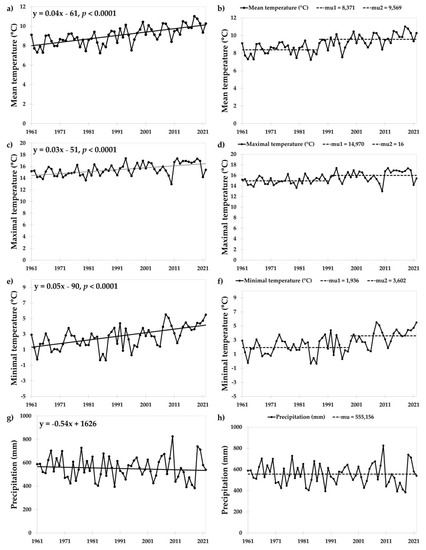
Figure 1
Open AccessArticle
Evaluation of the Relationship between Cultivar, Endophyte and Environment on the Expression of Persistence in Perennial Ryegrass Populations Using High-Throughput Phenotyping
Agronomy 2023, 13(9), 2292; https://doi.org/10.3390/agronomy13092292 - 30 Aug 2023
Abstract
Perennial ryegrass (Lolium perenne L.) is a commonly grown pasture species in temperate agriculture, mainly serving as a primary energy source for dairy cows. However, its limited persistence often leads to missed production potential and early resowing, especially in countries that experience
[...] Read more.
Perennial ryegrass (Lolium perenne L.) is a commonly grown pasture species in temperate agriculture, mainly serving as a primary energy source for dairy cows. However, its limited persistence often leads to missed production potential and early resowing, especially in countries that experience summer drought, e.g., Australia and New Zealand. Therefore, understanding the factors influencing perennial ryegrass pasture persistence is crucial for sustainable land management and climate resilience in pasture-based animal production systems. Significant gaps in knowledge exist regarding the factors influencing pasture persistence, as the number of conducted studies in this area remains limited. This study aimed to investigate the factors influencing the expression of persistence in perennial ryegrass populations using airborne and ground-based sensors. A field experiment was conducted in the southwest region of Victoria, Australia, involving ten commercial perennial ryegrass cultivar–endophyte combinations in two different populations. Persistence was evaluated using sensor-based and conventional pasture measurements over two consecutive autumns. The results revealed significant fixed effects of cultivar, endophyte, and environment and their interactions on persistence traits of perennial ryegrass. Cultivars Alto, Samson, and One50 exhibited high levels of persistence when infected with novel endophyte strains. Furthermore, prolonged environmental stresses were found to drive directional selection within pasture populations. The findings emphasise the importance of selecting appropriate cultivar–endophyte combinations and early detection of signs of poor persistence to optimise sward longevity and financial returns from pasture-based animal production systems. This study fills a knowledge gap regarding the factors influencing pasture persistence and provides valuable insights for sustainable pasture management strategies.
Full article
(This article belongs to the Special Issue Grassland and Pasture Ecological Management and Utilization)
►▼
Show Figures

Figure 1
Open AccessArticle
Agro-Based Spent Mushroom Compost Substrates Improve Soil Properties and Microbial Diversity in Greenhouse Tomatoes
by
, , , , , , , , and
Agronomy 2023, 13(9), 2291; https://doi.org/10.3390/agronomy13092291 - 30 Aug 2023
Abstract
►▼
Show Figures
Spent mushroom compost (SMC) substrates are commonly used as growth media for greenhouse crops and horticulture production. This study aimed to investigate the responses of physiochemical soil properties, enzyme activities, and microbial community compositions to different cultivation durations and SMC soil treatments on
[...] Read more.
Spent mushroom compost (SMC) substrates are commonly used as growth media for greenhouse crops and horticulture production. This study aimed to investigate the responses of physiochemical soil properties, enzyme activities, and microbial community compositions to different cultivation durations and SMC soil treatments on tomatoes. The experiment included the following treatments: SMC substrate and the surrounding soil after planting at 1, 3, and 7 years and comparing control treatments including non-planting SMC substrates and continuous mono-cropping soil. The results revealed that the SMC substrates had higher contents of total N P and organic C nutrients than the surrounding soil treatments. The physicochemical soil properties and soil enzyme activities of the SMC substrates were significantly decreased with longer cultivation duration. Microbial alpha diversity was higher in the SMC substrates regardless of cultivation duration than in the control treatments. It was observed that many beneficial microbes, such as bacteria of the Deinococcus-Thermus, Halanaerobiaeota, and Nitrospirae phyla, and the fungi of the Basidiomycota, Mortierellomycota, and Chytridiomycota phyla were enriched in the SMC substrates. The SMC substrate and surrounding soil had enriched several potentially beneficial microorganism genera such as the bacterial Saccharimonadales, Gaiella, Bacillus, and the fungal Thermomyces, Kernia, and Mortierella. Therefore, the agro-based SMC substrate grooved cultivation system is recommended as an environmentally compatible practice for tomato growth in the greenhouse.
Full article
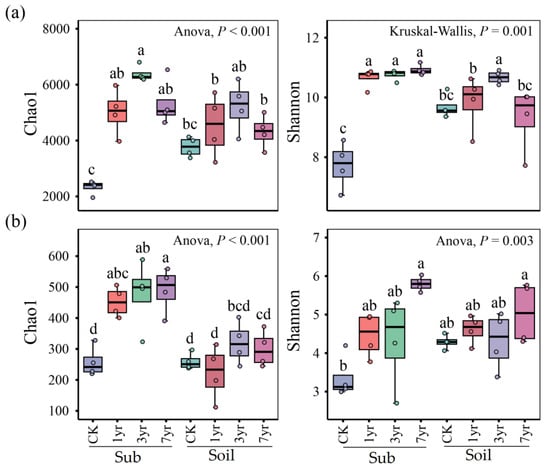
Figure 1

Journal Menu
► ▼ Journal Menu-
- Agronomy Home
- Aims & Scope
- Editorial Board
- Reviewer Board
- Topical Advisory Panel
- Instructions for Authors
- Special Issues
- Topics
- Sections & Collections
- Article Processing Charge
- Indexing & Archiving
- Editor’s Choice Articles
- Most Cited & Viewed
- Journal Statistics
- Journal History
- Journal Awards
- Society Collaborations
- Conferences
- Editorial Office
Journal Browser
► ▼ Journal BrowserHighly Accessed Articles
Latest Books
E-Mail Alert
News
Topics
Topic in
Agronomy, Diversity, Ecologies, Microorganisms, Plants
Plant-Associated Microbiota: From the Assembly to the Function
Topic Editors: Alessandra Salvioli Di Fossalunga, Vincenza CozzolinoDeadline: 30 September 2023
Topic in
Agriculture, Agronomy, Crops, Plants, Viruses
Plant Virus
Topic Editors: Munir Mawassi, Sergey MorozovDeadline: 31 October 2023
Topic in
Agriculture, Agronomy, Crops, JoF, Plants
Interaction between Plants and Fungi and Oomycetes
Topic Editors: Ana P. G. C. Marques, Nadia Massa, Santa Olga CacciolaDeadline: 30 November 2023
Topic in
Agriculture, Agronomy, Logistics, Sensors, Sustainability
Circular Economy and Digital Technologies in Agriculture
Topic Editors: Charisios Achillas, Dionysis Bochtis, Dimitrios AidonisDeadline: 31 December 2023

Conferences
Special Issues
Special Issue in
Agronomy
The Role of Symbiotic and Pathogenic Microbes in Insect-Host Plants Interactions
Guest Editors: Letian Xu, Zhanghong Shi, Jacob D. WickhamDeadline: 1 September 2023
Special Issue in
Agronomy
Predictions and Estimations in Agricultural Production under a Changing Climate
Guest Editors: Gniewko Niedbała, Magdalena Piekutowska, Tomasz Wojciechowski, Mohsen NiazianDeadline: 20 September 2023
Special Issue in
Agronomy
Social-Ecologically More Sustainable Agricultural Production
Guest Editors: Moritz Von Cossel, Joaquín Castro-Montoya, Yasir IqbalDeadline: 30 September 2023
Special Issue in
Agronomy
Agricultural Environment and Intelligent Plant Protection Equipment
Guest Editors: Xiongkui He, Fuzeng Yang, Baijing QiuDeadline: 15 October 2023
Topical Collections
Topical Collection in
Agronomy
Advances of Agricultural Robotics in Sustainable Agriculture 4.0
Collection Editors: Xiangjun Zou, Yunchao Tang, Junfeng Gao, Liang Gong, Simon van Mourik, Ya Xiong
Topical Collection in
Agronomy
Machine Learning in Digital Agriculture
Collection Editors: Thomas Scholten, Karsten Schmidt, Ruhollah Taghizadeh-Mehrjardi
Topical Collection in
Agronomy
A Series of Special Reviews and Topic Analyses That Explore Major Trends and Challenges in Agronomy
Collection Editors: Peter Langridge, Leslie A. Weston, Ilias Travlos
Topical Collection in
Agronomy
Agro-Ecology for Grassland-Based Farming Systems
Collection Editor: Gianni Bellocchi



